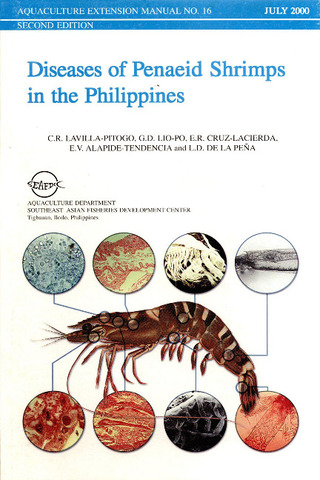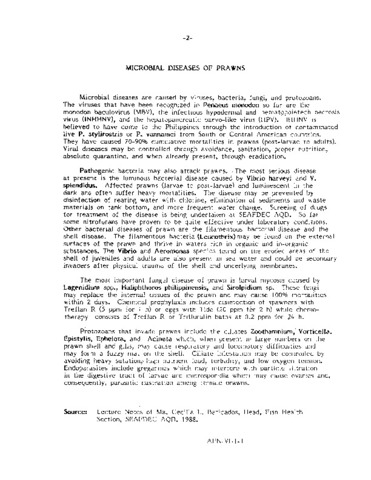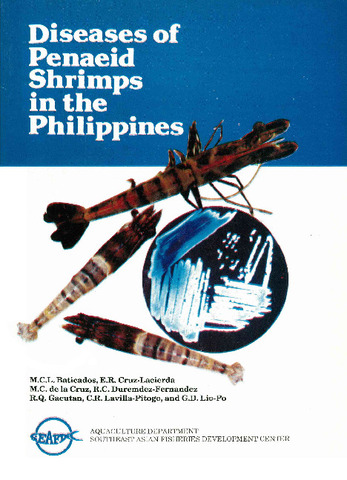Perlihatkan publikasi sederhana
Bacterial diseases in shrimp (Penaeus monodon) culture in the Philippines
| dc.contributor.author | Lavilla-Pitogo, Celia R. | |
| dc.contributor.author | de la Peña, Leobert D. | |
| dc.date.accessioned | 2013-11-18T08:50:38Z | |
| dc.date.available | 2013-11-18T08:50:38Z | |
| dc.date.issued | 1998 | |
| dc.identifier.citation | Lavilla-Pitogo, C. R., & de la Peña, L. D. (1998). Bacterial diseases in shrimp (Penaeus monodon) culture in the Philippines. Fish Pathology, 33(4), 405-411. | en |
| dc.identifier.issn | 0388-788X | |
| dc.identifier.uri | http://hdl.handle.net/10862/1747 | |
| dc.description.abstract | The hatchery system for Penaeus monodon evolved from the Japanese community culture system to the modified Galveston method and this shift in culture technique triggered the outbreak of diseases due to opportunistic bacteria. Whereas, sporadic infestation with filamentous bacteria and shell disease were the main bacterial diseases seen in earlier larval culture systems, hatcheries using the modified Galveston method experienced disease outbreaks due to systemic bacterial infection. Although several types of vibrios have been implicated in the epizootics, the dominant species seen were non-sucrose-fermenting vibrios, mainly luminescent Vibrio harveyi. To understand the course of infection, the entry of bacteria in the hatchery was investigated by determining the components and additives which encouraged their growth and dominance. As a result, several approaches to prevent and control bacterial disease have been implemented such as water treatment, hygienic spawning and egg handling, maintaining ecological balance within the system, and chemotherapy. In shrimp grow-out culture, early reports of bacterial problems were limited to shell disease, filamentous bacterial infestation and tail rot. In the last quarter of 1993, however, mass mortality associated with massive bacterial infection in the digestive organ of shrimp started occurring and contributed largely to the collapse of shrimp grow-out activities. An epidemiological study was conducted to understand the spread of infection. Several approaches to prevent or control the problem have been attempted such as the use of reservoirs, water treatment, chemotherapy, maintaining ecological balance within the system through the application of probiotics, and other system modifications. | en |
| dc.language.iso | en | en |
| dc.publisher | Japanese Society of Fish Pathology | en |
| dc.subject | Penaeus monodon | en |
| dc.subject | Philippines | en |
| dc.subject | Luminescent vibrio | en |
| dc.subject | Shrimp disease | en |
| dc.title | Bacterial diseases in shrimp (Penaeus monodon) culture in the Philippines | en |
| dc.type | Article | en |
| dc.citation.volume | 33 | |
| dc.citation.issue | 4 | |
| dc.citation.spage | 405 | |
| dc.citation.epage | 411 | |
| dc.citation.journalTitle | Fish Pathology | en |
| seafdecaqd.library.callnumber | VF SJ 0582 | |
| seafdecaqd.databank.controlnumber | 1998-27 | |
| dc.subject.asfa | bacterial diseases | en |
| dc.subject.asfa | bacterioses | en |
| dc.subject.asfa | crustacean culture | en |
| dc.subject.asfa | vibriosis | en |
| dc.subject.scientificName | Penaeus monodon | en |
| dc.subject.scientificName | Vibrio harveyi | en |
Files in this item
| Files | Size | Format | View |
|---|---|---|---|
|
There are no files associated with this item. |
|||
Publikasi ini ada di koleksi berikut
-
Journal Articles [1258]
These papers were contributed by Department staff to various national and international journals.




